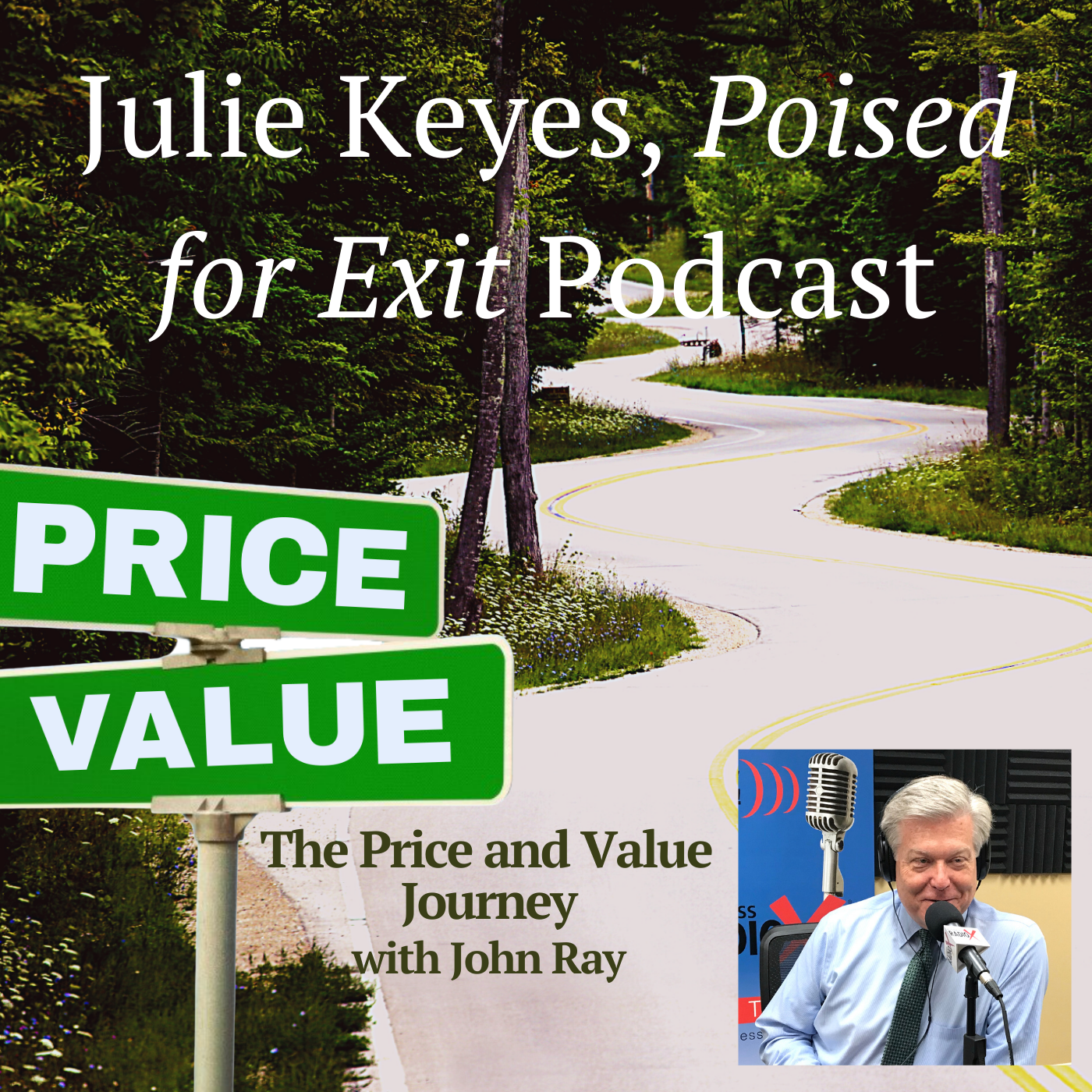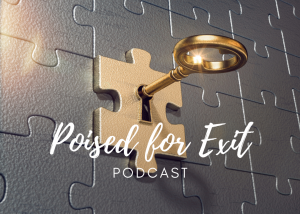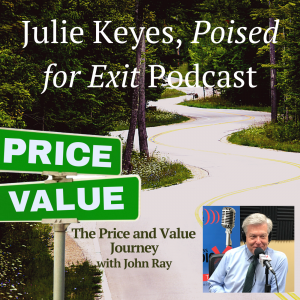
 Julie Keyes, Poised for Exit Podcast
Julie Keyes, Poised for Exit Podcast
My friend Julie Keyes is an exit planning expert based in the Twin Cities area. In an episode titled “Your Price is Too Low,” Julie interviewed me on her Poised for Exit podcast about pricing for professional services providers. We chatted about why I use the word “journey,” imposter syndrome, conducting value conversations with clients, why it’s vital to offer options, and much more. The Price and Value Journey is presented by John Ray and produced by the North Fulton studio of Business RadioX®.
TRANSCRIPT
John Ray: [00:00:00] Hello, I’m John Ray on the Price and Value Journey. I was honored to be invited to join my friend, Julie Keyes, on her Poised for Exit Podcast to chat about pricing for professional services providers. We chatted about why I use the word journey in the Price and Value Journey. We talked about imposter syndrome, conducting value conversations with clients, why it’s vital to offer options and more. I’m grateful to Julie for inviting me on her show. Now, here’s our conversation.
Julie Keyes: [00:00:32] Ladies and gentlemen, we are here today with John Ray, who is a consultant, speaker and radio host of RadioX. John, welcome to Poised for Exit.
John Ray: [00:00:43] Hey, Julie. It’s great to be here and I’m just so honored to be on your show. I’ve listened to it a lot, and you’ve got great guests, and I’m delighted and humbled to be part of that pantheon you’ve had. So, congratulations on that.
Julie Keyes: [00:00:55] Well. Thank you. Well, I have to say likewise, you’ve had a lot of really great content on your show too, and I hope to get into some of that today because our listeners are really going to be interested in what you have to say because so many of us, of the people who are in our listening audience would want to know and hear a lot of the advice that you’re going to dispense for us today. So, thank you for being on the show. And it took us a while to get you here. You’re a busy guy, and I’m a busy gal, and oh my gosh. But thank you for your patience.
John Ray: [00:01:26] Absolutely.
Julie Keyes: [00:01:26] And yeah. So, I’m really looking forward to this interview. Thanks for joining us today. Let’s just jump right in. I’d like to talk with you about the work that you do in pricing and helping professionals price their services because I know that there are a lot of advisors out there who are not pricing properly regardless of their discipline. And I’m sure you see it all the time because it’s the work that you do. So, how did you get into that and why?
John Ray: [00:01:53] Well, because I wasn’t doing it right, right?
Julie Keyes: [00:01:57] I’m sure, yeah.
John Ray: [00:01:58] I mean, I’ve got a whole drawer full of t-shirts about mistakes in pricing. And you know, I did not learn pricing, and pricing strategies, and value and how to discern value. I didn’t learn any of that in business education and my career. You know, the last statistic I saw, it was like, I believe it was five percent of business schools in this country actually have a course, a course, any course on pricing.
Julie Keyes: [00:02:34] Wow.
John Ray: [00:02:34] So, if you’re educated, come out with your MBA, you don’t have great education on pricing or maybe any. So, you learn the wrong thing. You learn to do market surveys, or you just do it by the seat of your pants or what have you, and you went, “That’s wrong.” And so, I made a lot of those mistakes and I had to fix that. And so, I had to do a lot of this work on my own. And I saw this in my clients. And I was so passionate about it after a time. It’s like, “I see this over and over and over again. I want to help in this regard.”
Julie Keyes: [00:03:19] And that is — boy, you hit the nail on the head there. When I think about pricing and conversations that I’ve had – and it’s not my specialty right – but I have made some recommendations to clients that they need to adjust their pricing. And so many times you ask, “When was the last time you had a pricing adjustment?” and they’ll say, “Oh, three years ago. Four years ago.” Yeah.
John Ray: [00:03:42] Yeah.
Julie Keyes: [00:03:42] And I think, you know, with the way things are now, I think we really need to be cognizant of that. But it’s amazing to me that the schools aren’t actually teaching it. So, what are they teaching? Are they teaching people to just follow the competition around and price according to what they’re doing?
John Ray: [00:03:56] Well, to be fair, I mean, this is a relatively newer discipline, not how to price, but the philosophy behind it because so much of pricing is really tied up in behavioral economics. And that’s a relatively new field, just a few decades old. And so, you really have to get into behavioral economics to properly price, right. And so, I think that’s the issue of it all. But what’s at stake here is that pricing is the fastest way to change your bottomline. Now, this is an accounting fact. They teach you that in accounting. You know, it’s faster than improving your marketing or getting more clients or anything. This is an accounting fact. It’s not up for argument. So, if you can just work on your pricing, you will dramatically change the trajectory of your business.
Julie Keyes: [00:04:59] And probably have more fun and work fewer hours too, right?
John Ray: [00:05:03] Getting the whole idea
Julie Keyes: [00:05:05] And we’re going to get to a good story in a little bit about that. I know we are. So, I know that the name of your show is The Price and Value Journey, and I love that. But speak to me about journey. Why did you call it The Price and Value Journey?
John Ray: [00:05:20] Well, I guess there’s three elements to that. Price is obviously one. Value, let’s get to that real quick. So, this is about value that is perceived by our clients, right? This is not about value that we perceive. It’s not about what we think we’re worth, even though we’re worth a lot, right? You’re worth a lot, I’m worth a lot. Our listeners, the work they do is fantastic worth. It’s what our clients perceive, and how we get to that, and how we can price relative to the value that they perceive.
And then, journey is that we’re on a journey of trying to get this right. I mean, give yourself grace because the most common thing that happens when I work with a client on their practice and their pricing is, “Wow, I can’t believe I did that,” and as we talk and they learn, they just beat themselves up. “I don’t know how I’m going to do all this.” Well, here’s the point – it’s a journey, okay. You’re not going to fix all this today, or tomorrow, or next week or even next year. It takes some time to work these things through. And so, give yourself grace.
And pricing is an art; it’s not a science. So, that’s the other piece of it. You can’t look up in the book and find out all the answers. You have to do some trial and error and testing to get from here to there. And so, that’s a journey.
Julie Keyes: [00:06:54] And I love that you said you’ve got to give yourself permission because I think that we, as advisors, at least, when I first started exit planning six or seven years ago, I just thought that I had to get it right right out of the gate. And like you said, it takes a while. You have to figure out. I don’t know. It is definitely a journey. I guess that’s why I wanted to ask you about it because I don’t think that a lot of people who are pricing professional services view it that way. I think that they feel pressured to make sure that they get it right. And unfortunately, I think a lot of them are still charging by the hour. And I know you don’t believe in that, either. Neither do I. That could be another whole show, John, right?
John Ray: [00:07:34] How long is this show, Julie?
Julie Keyes: [00:07:38] Yeah, yeah.
John Ray: [00:07:39] Well, yeah. Well, I mean, you know, a couple of things there. I mean, yeah, pricing by the hour, I call it a red flag of poor pricing. You know, if you’re pricing by the hour, your price is too low. That’s just by definition. And again, there’s a whole explanation behind that, and we can address that some other time. But you know, the other thing is, is that to get from here to there – and by here, I mean struggling and stuck in your practice, and a lot of people are struggling and stuck, or they’re working too hard for too little money, and that’s kind of struggling and stuck to. And if any of those things describe you, pricing is probably a problem. But to get from here to there, it takes a shift in mindset. It takes a lot of deep perspective change about where value is, and how value is perceived, and how you look at your practice and how the clients look at your practice. And that takes some time. It takes some adjustment.
Julie Keyes: [00:08:47] It does. And self-awareness, I would think, would be a part of that conversation too, right? Figuring out like, why do I feel like I’m not worth a certain amount of money or why do I? And is that in line with what the client would really want or expect, right?
John Ray: [00:09:05] Oh boy. I think I heard the imposter syndrome get flopped up on the desk, yeah?
John Ray: [00:09:11] Yeah. That’s what we’re talking about, right?
Julie Keyes: [00:09:13] Yeah. Yeah, yeah, absolutely. Yeah. And I bet you deal with that all the time,
John Ray: [00:09:18] All the time. And you know, that’s a case where you’re spending with your own wallet. Nobody would pay that, right? Well, what you’re really saying is you don’t think you would because you don’t trust yourself. And I know that you, whoever you is, I know you do great work, but it’s not about you, it’s about what the client perceives.
Julie Keyes: [00:09:45] Yes.
John Ray: [00:09:45] So, let’s let the client decide how to spend the money instead of you.
Julie Keyes: [00:09:49] How do you figure that out?
John Ray: [00:09:50] Yeah.
Julie Keyes: [00:09:51] Sorry.
John Ray: [00:09:51] No, no. Instead of you selling to your own wallet is one way to put it.
Julie Keyes: [00:09:57] Yeah, that’s a cool concept. I mean, it’s a good way to look at it, [but how do you figure out what the client is actually perceiving? How do you determine that?
John Ray: [00:10:07] So, that’s a value conversation. And that’s not a term I came up with. It’s not a concept I came up with. You know, there’s some great work out there by people like Ron Baker who talk about having a value conversation with clients. And what that is is diving into their hopes, dreams, aspirations, all the intangibles that are behind the reason they picked up the phone to call you to begin with. See, when somebody calls Julie, lets say — can I use you as an example?
Julie Keyes: [00:10:42] Sure.
John Ray: [00:10:43] When when they call Julie to look for help with their exit planning, what are they looking for? There’s more to it than just the request, the tactic that they’re wanting help with, right? They’ve got a strategy. They want to exit their business in five years. Their spouse is all after them saying, “You’re spending way too much time in this business. You need to get out. It’s destroying your health,” or some other reason or set of reasons. Those are values. Those are client values. And so, what that means is it’s more what’s at stake when you counsel a client is more than just, “Oh, let’s do an exit plan,” right?
Julie Keyes: [00:11:32] Oh, yeah, yeah.
John Ray: [00:11:33] It’s about getting that person to a place where they’ve got a happier home life, their spouse, they can reconnect with their spouse, their health is better. Those are priceless values. And so, you price relative to just the plan, not just the things, the tactics that you help them with and the strategies you help them with, but the big picture intangibles that mean so much to them that are behind the request.
Julie Keyes: [00:12:03] Well, and don’t you also help your clients determine if and when pricing packages or levels make sense, so they’re not just quoting one price, but they’ve got different offerings at different levels. Let’s talk about that for a second.
John Ray: [00:12:19] Yeah, thank you. So, yeah. So, options are powerful. And there’s a reason why, you know, the car companies, for example, have a small compact car, they have a medium kind of offering, and then they have luxury offering. I mean, there’s a reason why there’s small, medium and large. The dominant one-
Julie Keyes: [00:12:46] Just like at the Dairy Queen, yeah.
John Ray: [00:12:48] Yeah, there are choices. Exactly, there are choices. And what that’s a nod to is the fact that we have different values for different products and services. So, let’s take coffee, for example. I mean, I’m a cheapskate when it comes to coffee, so I would prefer just to come to your office and drink your coffee. But if I have to, I’ll go get the dollar coffee at the gas station right? Then, there are some people that they want the Starbucks. They’re going to sit in line for the Starbucks. And then, the most expensive cup of coffee in the United States is $75. It’s served once a year in one sitting in one party, and it’s sold out. And these are people that highly value coffee. They think coffee is like wine.
Julie Keyes: [00:13:36] Wow.
Julie Keyes: [00:13:37] More power to them. I mean-
John Ray: [00:13:38] Sure, yeah,
Julie Keyes: [00:13:39] I’m not criticizing. It just shows different values. So-
John Ray: [00:13:42] Of course.
John Ray: [00:13:44] If you can offer different options for your services, then you’re more likely to hit people more how they might value you. And I promise you, your prices will go up by definition because most people are pricing based on the basic. Their price is not based on the dollar cup of coffee, and not on the premium.
Julie Keyes: [00:14:07] Right. And I think, like you said before, I think that people really do value the ability to make a choice, right?
John Ray: [00:14:19] Absolutely.
Julie Keyes: [00:14:19] And I saw on a show not too long ago where they were talking about how to place items on a menu at a restaurant, and the things that they want you to buy that are in the middle of the road, so to speak, is going to be right in the middle, right where your your line of vision is. So, beware the middle of the menu.
John Ray: [00:14:39] Yeah. Yeah, they’ve got a lot of little tricks on those restaurant menus, for sure.
Julie Keyes: [00:14:45] Well, we to have our own tactics, don’t we, John?
John Ray: [00:14:48] Absolutely. Absolutely.
Julie Keyes: [00:14:50] Yeah. So, let’s talk about a client or two. Could you share a story about not necessarily — well, you talked about struggling and stuck. So, you took them from struggling and stuck to happy and not working all the time.
John Ray: [00:15:08] Well, let’s talk about — I mean, a number I could point to, and some of them are humorous, some of them are sad actually, but let’s talk about some specific numbers because we were just talking about options. So, I worked with a consultant who I won’t mention what they do, but they had their thing, and it was kind of a one-time thing that they did for busy professionals, and they charged $800 for it. That was the only option. Well, you could look at it from the outside and see there was a lot more value than $800 to it. And once we got through talking through all that, what we decided was his base offering should be $1500, not $800. And we built on options from there. And it’s a good, better, best model.
Julie Keyes: [00:16:09] Of course.
John Ray: [00:16:10] Right?
Julie Keyes: [00:16:10] Got it.
John Ray: [00:16:11] So, better has a little bit more than good, and best has a little bit more than better, and best is you’re like premium velvet rope option. So, we got good to $1500, we got better at $3300 for his thing, and then best I can only get him to $5000. I told him it ought to be $10,000. But we could get him to $5000, and I figure we’ve done good enough job there.
Julie Keyes: [00:16:43] Wow.
John Ray: [00:16:43] Well, the first time he went and offered this, he called me back, and he was so excited. The client he offered those options to pick the middle option, which means that’s at $3300 versus $800. So, the better option. And that’s obviously about four times more revenue than he has received.
Julie Keyes: [00:17:12] He had to be cartwheeling then.
John Ray: [00:17:14] He was pretty happy, right?
Julie Keyes: [00:17:16] Right.
John Ray: [00:17:17] Think about this now[. There’s there’s a couple of things here. That’s three fewer leads he’s got to worry about converting.
Julie Keyes: [00:17:24] Oh, exactly. Yes.
John Ray: [00:17:26] So, suddenly, he’s got a lot more time on his hands to better serve that client. And here’s the most important part for me because I get this all the time from people about you’re just trying to ring people out, you know, ring clients out. That’s not the point here. The point is that’s serving clients better. The client picked what they wanted, so they received much more value than what he had been selling before.
Julie Keyes: [00:17:52] Exactly.
John Ray: [00:17:53] Yeah. So, they picked that because they saw value in it. And so, the client was better off. The consultant was better off.
Julie Keyes: [00:18:01] Everybody wins.
John Ray: [00:18:02] Everybody wins. That’s the whole idea here.
Julie Keyes: [00:18:04] Yeah. And that’s really the way things can be more sustainable, right, is if everybody is going to win. So, well, one thing I wanted to touch on really quick that you talked about in one of your recent shows was on consistency. And so, let’s briefly discuss consistency. Obviously, we could go on for that personal life, business life. We could go on for a long time about that. But as it relates to your work, let’s talk about that for a little bit.
John Ray: [00:18:35] Sure. So, consistency, I mean, everybody intellectually agrees that consistency is important. You know, it’s another thing to be consistent in a way that you’re building trust with clients. So, you know, there’s a lot of aspects to this. One is to be consistent about all the right things that clients care about. You know, not about maybe what you think is important, but what the client thinks is important. So, it’s about understanding what their values are, right? I mean, if you’re not delivering that report they’re looking for every month, but you haven’t asked about what report they’re looking for, you know, that’s kind of on you. You’ve got to figure that out, so you can be consistent about the things that are important to them in their minds.
You know, consistency is one of those things that sometimes I think we as professional services providers, particularly smaller firms, certainly solopreneurs have a problem delegating, right? So, if you don’t have a VA, go get a VA. Spend the money. I’m sorry. Go spend the money and get a VA that will help you be consistent, and you can download some of this too, right? They can help you with that.
Julie Keyes: [00:19:57] Yes.
John Ray: [00:19:57] Or if you’ve got a VA, and they’re not doing the job, get another one. Or maybe you need to reposition your people if you’ve got employees, but they can help the overall consistency of the firm and how it delivers what it delivers. So, this is where automation can help you. This is where systems can help you. This is where having a operations manual can help you. I dare say that most professional services practices that are small solopreneurs and medium or small firms do not have an operations manual.
Julie Keyes: [00:20:38] So, if something happened to them, there’s no way anybody could continue the business because they wouldn’t know what to do. Yeah, yeah.
John Ray: [00:20:45] Well, that is certainly true, but the fact that you haven’t done that means you haven’t sit and thought about your process very much. And just like how writing helps you clarify your thoughts about something, you know about this because you do a lot of writing, if you do an operations manual and a process flow, it helps you think more clearly about what’s going on in your practice and how things happen, right? And you can remove some of those frictions that make you inconsistent.
Julie Keyes: [00:21:17] Great advice. Great advice. I’m going to do that myself. I have some processes documented but some, I don’t. And much of that I was forced to do when I hired my first VA. And so, for those of you out there who don’t have a VA, this will force you to articulate your processes in writing, for sure.
John Ray: [00:21:38] There you go.
Julie Keyes: [00:21:38] So, give us a couple action items, John. We could keep going, but we got to wrap up. So, what are a couple of things that our listeners could do right away that would make a difference?
John Ray: [00:21:48] Go raise your price. So-
Julie Keyes: [00:21:48] Easy, raise your price.
John Ray: [00:21:53] Well, here’s how I’ll make it easy. I mean, if you haven’t raised your prices in — certainly, the person you described, the situation you described where they didn’t raise their prices in three or four years, I mean, look what’s happening with inflation. Raise your prices, please. So, you don’t have to go out and raise your price by 50 percent tomorrow, but raise your price. And in a one-percent price increase, nobody will even notice. I mean, they won’t care. But just go raise your price. And do it for new clients. Just do it for new clients that you get. You don’t have to worry even about your legacy book, necessarily, although you need to get into that, but raise your pricing for new clients. Start thinking about options. How can I deliver options? What’s my good, and better and best? And why am I delivering the best that I’ve got the velvet rope treatment for every client? Why am I doing that? Because if you’re doing that, you’ve got nice clients and good clients, but they’re not really paying you for the velvet rope treatment, but you’re giving it to them.
Julie Keyes: [00:23:13] Yes.
John Ray: [00:23:14] So, develop options in your practice.
Julie Keyes: [00:23:18] Wonderful advice. What’s the best way for our listeners to reach you? Because I’m sure they’re going to want to learn more?
John Ray: [00:23:24] Sure, folks can go to my website, johnray.co. You can email me John@JohnRay.co. If you want to listen to my show on The Price and Value Journey, you can go to priceandvaluejourney.com to see the show archive and of course, on your favorite podcast app, as the old saying goes.
Julie Keyes: [00:23:53] Fantastic. And we will have all of that in the show notes, John. Thank you so much for being on the show today. Wonderful advice. I can’t wait to hear what our listeners have to say about it. And for you, our listeners, you will be able to find this, of course, and all our other episodes on the Poised for Exit website available for download at any time. Thanks for joining us, and please join us again next time.
John Ray: [00:24:15] There you have it. I’d like to thank Julie Keyes so much for her kind invitation to join her as a guest on Poised for Exit. If your professional services practice has a bent toward assisting business owners with exit planning or you’re actually one of those business owners looking ahead to an exit, you need to know Julie and subscribe to her podcast. One thing I love about her is that she’s been a founder and operator of several companies, and she’s actually been through her own business exit. In other words, she’s got hands on expertise and experience to bring to the table for her exit planning clients.
I’m a subscriber and a regular listener to her show, and it’s terrific. You can find the show on your preferred podcast app, of course, but if you go to PoisedForExit.com, you’ll find not only past editions of the show, but a ton of great resources, including Julie’s book also titled Poised for Exit. There’s a ton of resources and information about Julie’s work at her website, KeyeStrategies.com. That’s KeyeStrategies.com. If you want to get in touch with Julie directly, email her at Julie@KeyeStrategies.com. Again, that’s KeyeStrategies.com. Thanks again to Julie for having me on her show. And thank you for listening to this edition of The Price and Value Journey.
Julie Keyes, Founder and President, KeyeStrategies, and Host of Poised for Exit

Julie Keyes is the founder and owner of KeyeStrategies, LLC in Minneapolis, MN, specializing in exit and transition consulting for business owners of lower middle-market companies. Julie has been an entrepreneur most of her life. As the founder and operator of several companies, she understands owner motivations and the balancing act they require to work both ‘in’ and ‘on’ the business.
Julie is a Certified Exit Planning Advisor and Value Growth Advisor. She works with business owners who seek to understand and maximize their exit and critical transition options. She founded the Exit Planning Institute Twin Cities Metro Area Chapter in 2016, serving as president until 2020, and is a faculty member for their CEPA program. In addition, Julie was awarded EPI’s 2017 “Leader of Year”.
Julie’s first book, Poised for Exit, helps owners of privately held companies navigate the process of business exit. Her weekly podcast, of the same name, provides content relevant to business owners and advisors alike and can be found on all major podcast platforms.
LinkedIn | Twitter | Poised for Exit
About The Price and Value Journey
The title of this show describes the journey all professional services providers are on: building a services practice by seeking to convince the world of the value we offer, helping clients achieve the outcomes they desire, and trying to do all that at pricing which reflects the value we deliver.
If you feel like you’re working too hard for too little money in your solo or small firm practice, this show is for you. Even if you’re reasonably happy with your practice, you’ll hear ways to improve both your bottom line as well as the mindset you bring to your business.
The show is produced by the North Fulton studio of Business RadioX® and can be found on all the major podcast apps. The complete show archive is here.
John Ray, Host of The Price and Value Journey

John Ray is the host of The Price and Value Journey.
John owns Ray Business Advisors, a business advisory practice. John’s services include advising solopreneur and small professional services firms on their pricing. John is passionate about the power of pricing for business owners, as changing pricing is the fastest way to change the profitability of a business. His clients are professionals who are selling their “grey matter,” such as attorneys, CPAs, accountants and bookkeepers, consultants, marketing professionals, and other professional services practitioners.
In his other business, John is a Studio Owner, Producer, and Show Host with Business RadioX®, and works with business owners who want to do their own podcast. As a veteran B2B services provider, John’s special sauce is coaching B2B professionals to use a podcast to build relationships in a non-salesy way which translate into revenue.
John is the host of North Fulton Business Radio, Minneapolis-St. Paul Business Radio, Nashville Business Radio, Alpharetta Tech Talk, and Business Leaders Radio. house shows which feature a wide range of business leaders and companies. John has hosted and/or produced over 1,100 podcast episodes.
 Julie Keyes, Poised for Exit Podcast
Julie Keyes, Poised for Exit Podcast













